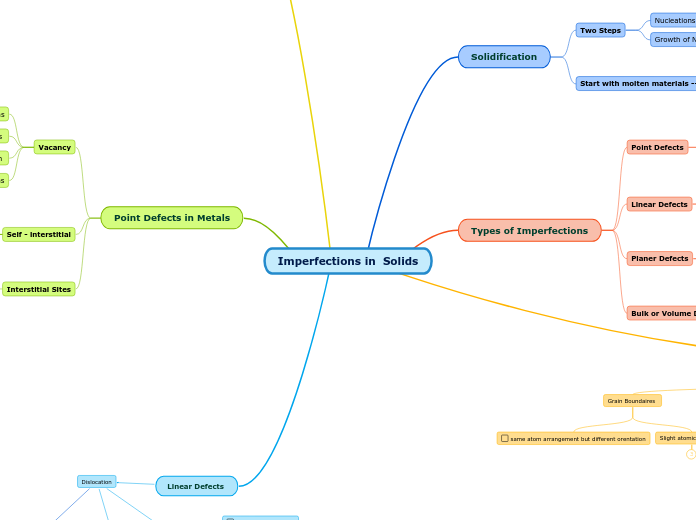Imperfections in Solids
Solidification
Two Steps
Nucleations
Growth of Nuclei
Start with molten materials --- All liquid
Nuclei
Crystal growing
Grain Structure
Types of Imperfections
Point Defects
Involves 1 or 2 atomic/ionic positions
Vacancies; Interstitial; Atoms; Substitutional; Impurity Atoms
Linear Defects
Some atoms are misaligned; Occur along a line only
Edge/Screw/Mixed Dislocations
Planer Defects
Boundaries or planes separate a materials into region
Grain Boundaries; Twain Boundaries; Stacking Faults
Bulk or Volume Defects
Introduced during fabrication processes
Cracks; Pores; Voids; Precipitates; Foreign Inclusions
Planer Defecs
Grain Boundaires
same atom arrangement but different orentation
Slight atomic Disorder
Twain Boundaries
mirror reflections of atoms position across twin planes
Found in FCC(annealing) and BCC or HCP(mechanical0
Stacking
Found in FCC metal
Occur when errors present in the planer stacking sequence
Impurities in Metals
Metal Alloy
Mixture of a metal and a non-metal
can include multi-phase mixtures
Have enhanced properties
Solid Solutions
Substitutional Solid Solutions
Increase the strenght of metallics materials
Replace host ones in lattice sites
Different sizes disturb surronding crystal structures
Number of defects is independent of temperatures
Interstitial solid solutions
Extra atoms/ions placed in normally unoccupied positions
Impurity latoms smaller than hosts
max concentration of impurity is < 10%
Number of atoms remains constant with temperature
Point Defects in Metals
Vacancy
Result from missing atoms
Found in all crystalline materials
Computation of Equilibrium Concentration
Exchange position with neighboring atoms
Self - interstitial
Host atoms are crowded into interstitial sites
Found in crystal structures having low packing factor
Not occur naturally
Exist in very small concentrations
Interstitial Sites
Both FCC and BCC are octahedral and Tetrahedral
BCC Tetrahedral Sites
4* 1/2* 6 = 12 tetrahedral sites/cells
24 face sties
BCC Octahedral :
6 face-center sites & 12 edges sites
1/2* 6 + 1/4 *12 = 6 Octahedral sites/cell
Linear Defects
Dislocation
Screw
Form by shear stress
Burgers Vector : b
perpendicular to dislocation line slip direction
parallel to screw dislocation
Edge
Burgers Vecter : b
Perpendicular to edge dislocation, parallel to line slip dislocation
Shows atom slip, magnitude, and direction
Mixed Dislocation
Dislocation alters direction
Permanent Deformation
Move when stresses applied
Burgers stay constant
Nv= N exp = (-Qv/KT)
